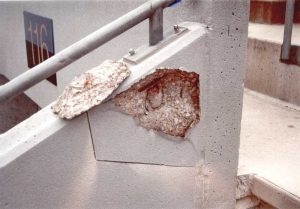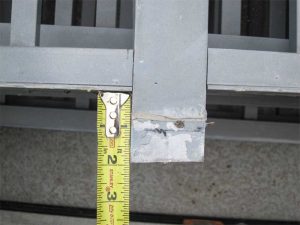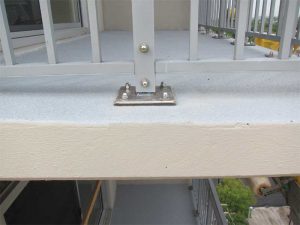Did we just hit steel?

Most railing systems are not field-adjustable. Therefore, coordinating the rail post anchorage locations with other embedded items becomes extremely important. Installing sleeves for post pockets prior to pouring the concrete has the advantage of avoiding interference with other embedded items and avoiding the messy core drilling step. However, the locations of the rail posts need to be known early in the project, well before concrete placement. The railing and reinforcement installers and concrete subcontractor all need to be involved with coordinating the sleeve locations. Any errors in locating the sleeves lead to core drilling or expensive alterations of the railing system.
Core drilling post pockets or drilling for post-installed anchors is generally favored over sleeve or embed installation as it gives the railing installer flexibility about post location, is cheaper, and eliminates the pre-pour installation processes. However, lack of coordination of anchorage locations can lead to interference with the embedded items. Further, field modifications made to accommodate the interference can be problematic. Installed anchorages can conceal a multitude of sins, such as severed steel reinforcement, shortened rail post ends, and cut post-installed anchors. On one project that was investigated by the authors, reinforcement was hit on nearly every post hole, with the installer opting to either sever the steel or cut off the end of the post (Figure 9), shortening the post, and reducing the embedment, thereby weakening the anchorage. Resolving the issue involved:
- removal of the railing assemblies;
- cleaning out the (inappropriate) grout;
- chipping out the concrete at each post location;
- installation of supplemental reinforcing steel;
- placement of new concrete; and
- installing base plates on each post (Figure 10).

This situation can be avoided by taking the extra step to specifically require the coordination of rail post locations with the embedded items prior to casting concrete. Shifting and adjusting rebar and conduit locations can be done with much less effort than repairing it after the concrete has been placed.
Recommendations
Rail post anchorages need to be designed; they cannot simply be selected, or worse, ignored. Questions to be asked in the design phase include:
- are there proper load paths to the different supporting structural elements;
- can the structural element support the proposed rail post base reactions;
- is the edge distance adequate;
- can all construction tolerances be accommodated;
- if the design is delegated, have all the requirements been properly conveyed to the delegated designer; and
- has the delegated design been properly checked by the project’s EOR?

It is best to not use gypsum-based grout in an exterior application. The specifications should preclude grouts with gypsum-based binder. A product may be unsuitable for outdoor use if it cannot get wet. Many materials meet the non-shrink criteria and are suitable for outdoor, freeze-thaw environments.
Lastly, it is recommended to predetermine post anchor locations and coordinate the locations with embedded items. It is pertinent to note railing system installation is an integrated process requiring input from and coordination of more than one party.





I would love to post this story on my website. Is that possible?